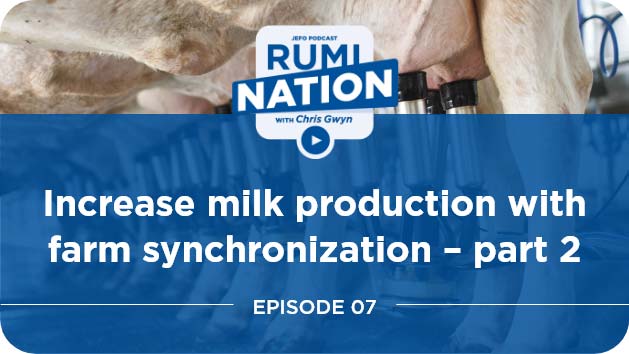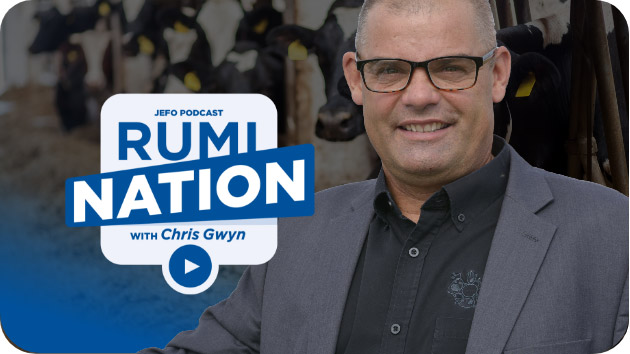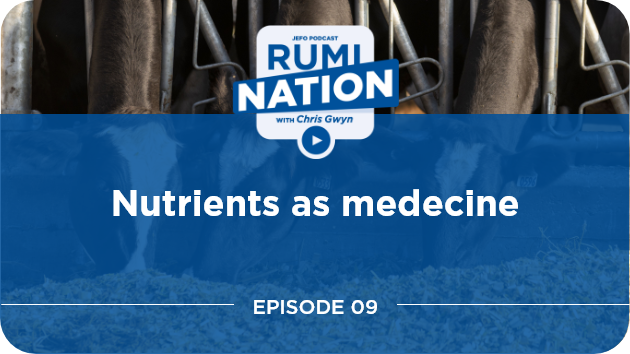RumiNation | S02 : E08
The Key Profitability Drivers of
Today’s Dairy Farms
Brought to you by Jefo Nutrition
Share now!
Did you enjoy this episode?
Share now!
The Key Profitability Drivers of Today’s Dairy Farms
What are the key profit drivers that producers should take into consideration when managing their dairy farm? Is transition cow health a big deal, and how could we improve it? What about the role of B vitamins?
Learn everything you need to know about the key profitability drivers of today’s dairy farm with Dr. Mike Hutjens.
Our guest - Dr. Mike Hutjens
Dr. Hutjens is a professor of Animal Sciences at University of Illinois. He was born in Green Bay, Wisconsin, where he was raised on a dairy farm. In 1971, he earned his PhD at the prestigious University of Wisconsin – Madison.
He won the title of Extensionist of the Year, Outstanding Teacher in the United States, Most Influential Person in the American Dairy Industry, and received the ADSA Honor Award.

Timestamps & Summary
01:54:00 – Could you explain the path you took to become who you are today?
Dr. Hutjens grew up on a 70-cow grade Holstein farm in the 1950s. He went to a Community College for a year, and then down to Madison to get his degree, where he got a chance to work in a mastitis lab and in the dairy science department. When he met Dr. Jim Crowley and Dr. Dave Dixon, he fell in love with the job and that got him to pursue in that area. He then had a chance to go to the University of Minnesota for 8 years as an extension dairy specialist. When a position opened up at the University of Illinois in 1979, he moved there.
03:52:00 – Could you expand on what you feel are some of the key profitability drivers on a dairy farm today?
The first 5 key profitability drivers that come to Dr. Hutjens’ mind are:
1. A successful transition management and feeding program.
2. Feed efficiency (how effective your cows convert dry matter to milk production).
3. Never giving up milk. In other words, in the US, feed costs are up 20-25% (about $0.12 per pound of dry matter). The good cows are going to give 2 pounds of milk, and that’s going to be anywhere around 38 to 42 cents depending on components. And anytime we can trade a powder dry matter $0.12 for an income of over $0.40, that’s a trade.
4. Focusing on milk components. Milk protein is now really valuable, and it’s probably going to stay that way in the world because people want animal protein.
5. Heifer enterprise. A heifer enterprise can be very expensive, and as a result, we have to have the right number of cows, the technologies, etc. So, we look at profitability.
05:51:00 – Could you expand a bit more on what we should be doing today in our dairy operations to ensure and enhance transition cow health?
One of the key factors is going to be unique diets. We’re now looking at 1200 grams of metabolizable protein in the close-up diet when reforming claustrum, and the calf is really taking lots of amino acids away from the cow.
Another factor is a fresh cow philosophy, which allows to monitor the cows so that the first 10 or 12 days after calving, we make sure that they are off to a good start before we move them into a higher production group or category. And this can happen on smaller or bigger farms, it’s just a matter of getting the right nutrients in and adjustments to those animals.
7:24:00 – Could you take a few minutes and expand on your knowledge about the role that B vitamins play in the metabolism and the biology of dairy cows?
The whole B vitamin is kind of a challenging area.
For example, biotin is a B vitamin that really can improve milk production and improve genetics, energetics, and the whole health.
While choline is not considered to be a true B vitamin, it’s also very important and certainly the rumen-protected choline products have performed extremely well.
Niacin is another B vitamin that comes into play, along with folic acid in terms of energetics and defining sparing in cows.
And there’s the B12 vitamin that has some effects on the metabolism or propionic acid, which becomes a key resource for blood glucose in the early lactation.
10:18:00 – What is the list of feed ingredients that people should be really considering to meet your objectives of profitability on dairy farms?
Dr. Hutjens explains how the rumen-protected choline is going to be a home run as it’s working very effectively at increasing profitability and maintaining good liver function. Biotin has also given impressive results on milk production.
12:36:00 – What should producers and nutritionists focus on when they’re trying to drive profitability on their dairy farm?
A very large study, a meta-analysis, looked at the rumen-protected vitamins on a commercial basis. They found out that on average they were getting about 2 ½ pounds or a litre pound more milk. The probability of having the same effect on your farm is 99,99%.
Besides the improvement in milk production, they also could track out animal health and performance, which also gave significant results. The last thing they looked at was getting cows pregnant in the first 100 days, and they saw about a 10% improvement in pregnancy rates. They also saw that it was also cost-effective.







